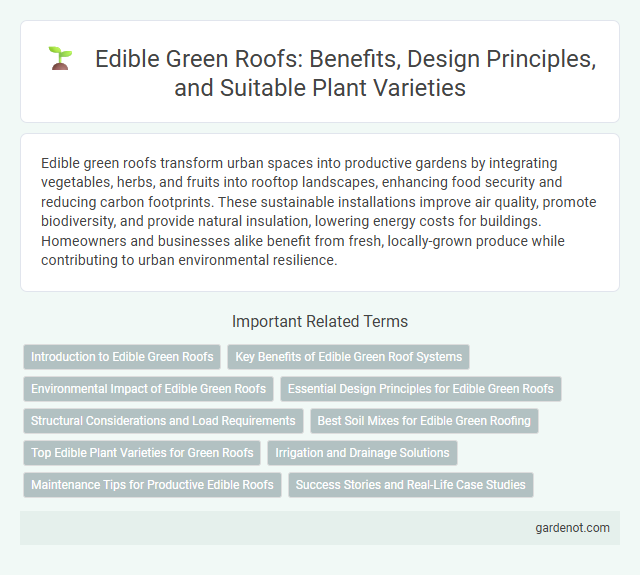Edible green roofs transform urban spaces into productive gardens by integrating vegetables, herbs, and fruits into rooftop landscapes, enhancing food security and reducing carbon footprints. These sustainable installations improve air quality, promote biodiversity, and provide natural insulation, lowering energy costs for buildings. Homeowners and businesses alike benefit from fresh, locally-grown produce while contributing to urban environmental resilience.
Introduction to Edible Green Roofs
Edible green roofs integrate sustainable urban agriculture with traditional green roofing by growing fruits, vegetables, and herbs on building rooftops. These systems improve urban food security, reduce heat island effects, and enhance biodiversity while providing insulation benefits. Optimized substrate layers and lightweight materials ensure structural compatibility and plant health in edible green roof installations.
Key Benefits of Edible Green Roof Systems
Edible green roof systems enhance urban sustainability by producing fresh, organic food directly on rooftops, reducing food miles and carbon footprint. These systems improve building insulation, cutting energy costs by regulating temperature and managing stormwater runoff effectively. Integrating edible plants fosters biodiversity and supports local ecosystems while promoting community engagement and food security.
Environmental Impact of Edible Green Roofs
Edible green roofs contribute significantly to urban sustainability by enhancing local biodiversity and reducing the urban heat island effect. These roofs improve air quality through natural filtration while mitigating stormwater runoff, thus decreasing the burden on municipal drainage systems. Incorporating edible plants promotes local food production, reducing carbon emissions associated with food transportation and supporting urban food security.
Essential Design Principles for Edible Green Roofs
Edible green roofs require essential design principles such as selecting lightweight, nutrient-rich soil substrates that support diverse plant varieties while minimizing structural load. Proper irrigation systems and drainage layers are crucial to maintain optimal moisture levels and prevent root waterlogging. Incorporating native and drought-resistant edible plants enhances sustainability and maximizes yield in rooftop environments.
Structural Considerations and Load Requirements
Edible green roofs demand careful structural considerations to support the additional load of soil, water, and mature plants, which can weigh between 60 to 150 pounds per square foot depending on the crop density. Load requirements must accommodate saturated soil conditions, irrigation systems, and the dynamic weight of growing vegetables, herbs, or fruits, often necessitating reinforced roofing materials and load-bearing capacity verification. Engineers and architects typically assess dead loads, live loads, and seismic factors to ensure the roof structure safely sustains the intensive weight and moisture retention integral to successful edible green roof installations.
Best Soil Mixes for Edible Green Roofing
Best soil mixes for edible green roofs combine lightweight materials with high nutrient retention, ensuring optimal plant growth and structural support. A blend of organic compost, peat moss, perlite, and vermiculite enhances moisture retention and aeration, while maintaining a balanced pH suitable for vegetables and herbs. Incorporating biochar or coconut coir can further improve soil fertility and sustainability for productive edible rooftop gardens.
Top Edible Plant Varieties for Green Roofs
Top edible plant varieties for green roofs include drought-tolerant succulents like sedum, nutrient-rich herbs such as thyme, oregano, and chives, and small vegetable crops like cherry tomatoes and strawberries that thrive in shallow soil layers. These plants offer excellent adaptability to rooftop conditions, requiring minimal maintenance while providing fresh produce and enhancing biodiversity. Selecting varieties with deep roots and high resilience ensures sustainable green roof performance and maximizes harvest potential.
Irrigation and Drainage Solutions
Edible green roofs require efficient irrigation systems like drip irrigation and automated sprinkler setups to maintain consistent moisture levels essential for plant health and productivity. Advanced drainage solutions, such as layered substrates with drainage mats and slope designs, prevent waterlogging while recycling excess water to reduce waste. Combining precise irrigation management with effective drainage ensures sustainable growth and maximizes yield in edible green roof installations.
Maintenance Tips for Productive Edible Roofs
Regular irrigation and using organic compost enhance soil fertility and support healthy growth on edible green roofs. Pruning and harvesting crops promptly prevent overgrowth and encourage continuous production. Monitoring for pests and diseases ensures timely intervention, maintaining plant health and maximizing yield.
Success Stories and Real-Life Case Studies
Edible green roofs have transformed urban spaces by integrating food production with sustainable design, as seen in Chicago's City Hall rooftop garden yielding over 20 varieties of vegetables and herbs annually. New York's Brooklyn Grange operates the world's largest rooftop soil farms, demonstrating high productivity with over 50,000 pounds of fresh produce harvested each year. These case studies highlight the potential for edible green roofs to enhance food security, reduce urban heat islands, and promote biodiversity in densely populated cities.
Edible green roof Infographic

 gardenot.com
gardenot.com